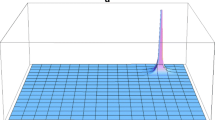Abstract
Extending the result of a previous paper, wherein elementary particles were considered to be an array of Planck scale oscillators, we show that the universe itself is the normal mode of a set of Planck scale oscillators.
Similar content being viewed by others
REFERENCES
B. G. Sidharth, Found. Phys. Lett. 15 (6), 577–583 (2002).
Y. Jach Ng and H. van Dam, Mod. Phys. Lett. A. 9 (4), 335–340 (1994).
D. L. Goodstein, States of Matter (Dover, New York, 1985), pp. 160ff.
N. Rosen, Int. J. Theor. Phys. 32 (8), 1435–1440 (1993).
B. G. Sidharth, Chaotic Universe: From the Planck to the Hubble Scale (Nova Science, New York, 2001), pp. 65ff.
B. G. Sidharth, Chaos, Solitons and Fractals 12 (1), 173–178 (2000)
A. V. Olinto, Phys. Rep. 333–334, 329–348 (2000).
S. Coleman and S. L. Glashow, Phys. Rev. D. 59 116008 (1999).
B. G. Sidharth, “Non-commutative geometry and issues,” Physics/0312109.
B. G. Sidharth, “A formula for the mass spectrum of elementary particles,” to appear in Hadronic J.
Sze Kui Ng, “A computation of the mass spectrum of mesons and baryons,” hep-ph/0208098.
C. Beck, Spatio-temporal Chaos and Vacuum Fluctuations of Quantized Fields (Advances in Nonlinear Dynamics, Vol. 21) (World Scientific, Singapore, 2002); hep-th/0207081.
C. Castro, Chaos, Solitons and Fractals 15, 797 (2003).
L. Nottale, Fractal Spacetime and Microphysics, Towards Scale Relativity (World Scientific, Singapore, 1992).
B. G. Sidharth, Chaos, Solitons and Fractals 15, 593–595 (2003).
D. Gross and P. Mende, Nucl. Phys. B 303, 407 (1998).
D. Amati, M. Ciafaloni, and G. Veneziano, Phys. Lett.B 216, 41 (1989).
C. Castro, Found. Phys. 30, 1301 (2000).
C. Castro, Chaos, Solitons and Fractals 11, 1721 (2000).
C. Castro, Chaos, Solitons and Fractals 12, 1585 (2001).
B. G. Sidharth, Int. J. Mod. Phys. A. 13 (15), 2599 (1998).
M. Kafatos, S. Roy, and R. Amoroso, “Scaling in cosmology and the arrow of time,” in Studies in the Structure of Time, R. Buccheri and M. Saniga, eds. (Kluwer Academic, Dordrecht, 2000), pp. 191–200.
J. Glanz, Science 22, 2156 (1998).
B. G. Sidharth, Nuovo Cimento B 115 (12), (2), 151 (2000).
J. P. Uzan, “The fundamental constants and their variations: observational status and theoretical motivations,” heph/0012539.
Y. Jack Ng., “Selected topics in Planck-scale physics,” hepth/0305019.
Author information
Authors and Affiliations
Rights and permissions
About this article
Cite this article
Sidharth, B.G. The Planck Scale in the Universe. Found Phys Lett 17, 503–506 (2004). https://doi.org/10.1023/B:FOPL.0000042701.61554.4c
Published:
Issue Date:
DOI: https://doi.org/10.1023/B:FOPL.0000042701.61554.4c




